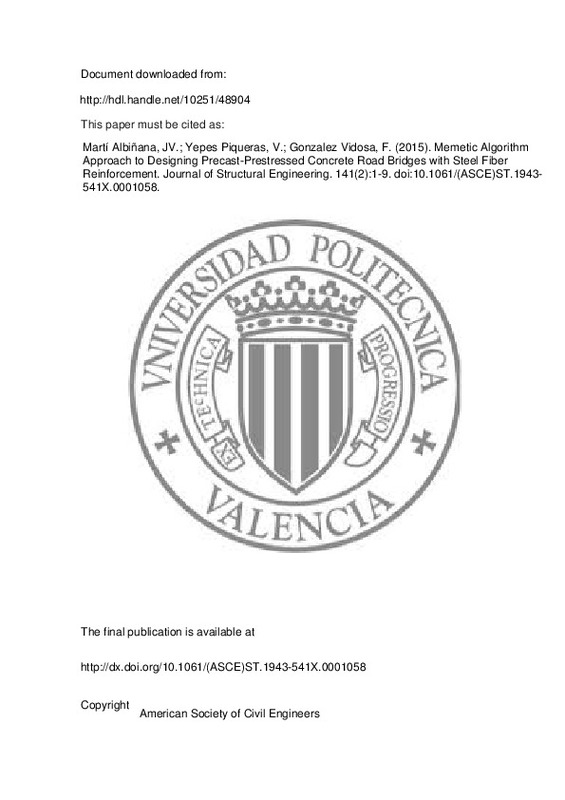Martínez Martín, FJ.; González Vidosa, F.; Hospitaler Pérez, A.; Alcalá González, J. (2011). Design of tall bridge piers by ant colony optimization. Engineering Structures. 33(8):2320-2329. https://doi.org/10.1016/j.engstruct.2011.04.005
Por favor, use este identificador para citar o enlazar este ítem: http://hdl.handle.net/10251/50293
|
Título:
|
Design of tall bridge piers by ant colony optimization
|
|
Autor:
|
Martínez Martín, Francisco Joaquín
 González Vidosa, Fernando
González Vidosa, Fernando

 Hospitaler Pérez, Antonio
Hospitaler Pérez, Antonio

 Alcalá González, Julián
Alcalá González, Julián
|
|
Entidad UPV:
|
Universitat Politècnica de València. Departamento de Ingeniería de la Construcción y de Proyectos de Ingeniería Civil - Departament d'Enginyeria de la Construcció i de Projectes d'Enginyeria Civil
Universitat Politècnica de València. Departamento de Ingeniería del Terreno - Departament d'Enginyeria del Terreny
|
|
Fecha difusión:
|
|
|
Resumen:
|
This paper describes a methodology for the analysis and design of Reinforced Concrete (RC) tall bridge piers with hollow rectangular sections, which are typically used in deep valley bridge viaducts. Piers are usually ...[+]
This paper describes a methodology for the analysis and design of Reinforced Concrete (RC) tall bridge piers with hollow rectangular sections, which are typically used in deep valley bridge viaducts. Piers are usually considered tall when the shaft has a height of 50 m or more. Three different types of rectangular hollow tall piers have been studied for road piers of 90.00 m in height: RTRA90, RLON90 and RLT90. RTRA90 has the two side walls inclined, RLON90 has the two frontal walls inclined and RLT90 has all four walls inclined. The procedure used in the present study to solve the combinatorial problem is a variant of the ant colony optimization. RTRA90 leads to the most economical pier, both in column and foundation cost, since it is the most efficient set up for horizontal loads. Regarding the cost of the vertical column only, i.e. excluding the foundation, the cost of RTRA90 and RLON90 are similar, but the cost of the column RLT90 is higher due to its larger unit cost of interior formwork. © 2011 Elsevier Ltd.
[-]
|
|
Palabras clave:
|
Ant colony optimization
,
Concrete structures
,
Economic optimization
,
Structural design
,
Tall bridge piers
,
Analysis and design
,
Ant-colony optimization
,
Combinatorial problem
,
Deep valley
,
Efficient sets
,
Formwork
,
Horizontal loads
,
Rectangular section
,
Side walls
,
Unit cost
,
Vertical columns
,
Algorithms
,
Artificial intelligence
,
Bridge piers
,
Costs
,
Reinforced concrete
,
Structural optimization
,
Walls (structural partitions)
,
Bridges
,
Algorithm
,
Bridge
,
Column
,
Concrete structure
,
Design
,
Foundation
,
Optimization
,
Pier
,
Soil-structure interaction
|
|
Derechos de uso:
|
Cerrado |
|
Fuente:
|
Engineering Structures. (issn:
0141-0296
)
|
|
DOI:
|
10.1016/j.engstruct.2011.04.005
|
|
Editorial:
|
Elsevier
|
|
Versión del editor:
|
http://dx.doi.org/10.1016/j.engstruct.2011.04.005
|
|
Código del Proyecto:
|
info:eu-repo/grantAgreement/MEC//BIA2006-01444/ES/DISEÑO OPTIMO SOSTENIBLE DE TABLEROS DE PUENTES LOSA PRETENSADOS/
|
|
Agradecimientos:
|
This study was funded by the Spanish Ministry of Education (research project BIA2006-01444). The authors are grateful for the thorough revision of the manuscript by Ms. Lia Wallon.
|
|
Tipo:
|
Artículo
|






![[Cerrado]](/themes/UPV/images/candado.png)



